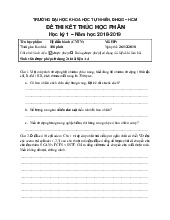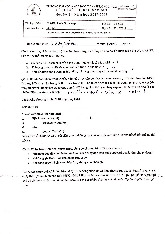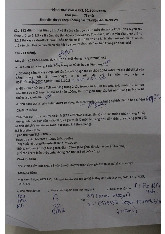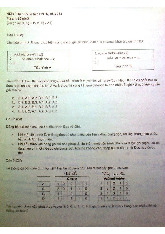



Preview text:
VNUHCM-UNIVERSITY OF SCIENCE - FACULTY OF INFORMATION TECHNOLOGY COURSE SYLLABUS
CSC10007 – OPERATING SYSTEM 1. GENERAL INFORMATION Course name: Operating System Course name (in Vietnamese): Hệ điều hành Course ID: CSC10007 Knowledge block: Basic Number of credits: 4 Credit hours for theory: 45 Credit hours for practice: 30 Credit hours for self-study: 90 Prerequisite : C/C++ Prior-course : Computer Systems Instructors Thái Hùng Văn 2. COURSE DESCRIPTION
In the theory part, students learn basic concepts, general architecture and main components of the
operating system such as process (and thread) management, memory management, file management, I/O
management. In the practice part, students learn how to implement some functionalities of an OS such
as process operations, semaphore to synchronize multiple threads, file system management. 3. COURSE GOALS Program ID Description LOs G1
Work on a personal and team level to present and solve a number of 2.1.1, 2.1.8,
operating system (OS) - related problem. 2.2, 2.3.1 G2
Know and explain English terminology related to OS. 2.4.3, 2.4.5 G3
Able to analyze and think systematically for practical problems. 4.1, 4.3 G4
Explain the basic concepts, terminology, and basic ethical principles ... 1.3.2, 3.3.1 related to the OS.
Course Syllabus Operating System Page 1/4
VNUHCM-UNIVERSITY OF SCIENCE - FACULTY OF INFORMATION TECHNOLOGY G5
Describe the organization and operation of the basic components of the OS 1.3.2, 1.4 G6
Apply general operating system knowledge to implement some examples of 5.3.2, 5.3.3,
the basic components of the OS. 6.2.1
4. LEARNING OUTCOMES (LOs) ID Description I/T/U G1.1
Establishment, organization, operation and management of the group. U, I G1.2
Participate in discussions on subjects. U G1.3
Technical analysis, synthesis and writing. U, I G2.1
Know and understand specialized English terminology of the subject. I G2.2
Read and understand English documents related to lectures. I G3.1 T
Able to analyze and think at the system level for problems: synchronization, file
organization on disk, process coordination, memory organization. G4.1 I, T
Explain the basic concepts of an operating system: file system, process / thread,
synchronization, user / system mode, system call, etc. G4.2 I, T
Understand essential knowledge about protection and security mechanism in an OS G4.3 I
Know how to update new knowledge, self-study, self-development and adaptation. G5.1 U, T
Present concepts, process structures, threads, process coordination algorithms:
FCFS, Round Robin, Priority, Multi-queue, ... G5.2 T
Describe synchronization mechanisms such as mutex, critical sector, semaphore,
monitor. Solve some classic synchronization problems: Dining Philosophers,
Consumer and Producer, Readers and Writers G5.3 T
Present the models of organization, allocation and management of main memory.
Explain the mechanism, virtual memory operation. G5.4 T
Present roles, models, FS structure. Describe FAT and INODE structure. G5.5 U,T
Present the organization model, how to access the input and output devices. G6.1 I, T
Able to use basic Linux operating system as basic commands G6.2 T
Able to develop some simple examples of essential OS components such as process
management (e.g. creation, communication), thread synchronization, ... in Linux
environment. From there, better understand the communication mechanism and operate the above components. 5. TEACHING PLAN
Course Syllabus Operating System Page 2/4
VNUHCM-UNIVERSITY OF SCIENCE - FACULTY OF INFORMATION TECHNOLOGY 5.1. THEORY PLAN Teaching Week Topic LOs Evaluation /Learning 1 Introduction to OS G2.1, G2.2, G4.1 Lecturing Final exam 2 Process
G2.1, G2.2, G3.1, G4.1, Lecturing Final exam G4.3, G5.1 Midterm exam 3 CPU Scheduling
G1.2, G2.1, G2.2, G3.1, Lecturing Final exam G4.1, G4.3, G5.1 Discussion Midterm exam Exercise#1 4
Thread and synchronization G2.1, G2.2, G3.1, G4.1, Lecturing Final exam G4.3, G5.2 Discussion Midterm exam 5 Deadlocks G2.1,G2.2, G3.1, Lecturing Final exam G4.1,G4.3 6 Memory management
G1.2, G2.1, G2.2, G3.1, Lecturing Final exam G4.1, G4.3, G5.3 Discussion Exercise#2 7 Virtual memory
G1.2, G2.1, G2.2, G3.1, Lecturing Final exam G4.1, G4.3, G5.3 Discussion Exercise#3 8 File management G2.1, G2.2, G3.1, G4.1, Lecturing Final exam G4.3, G5.4 Discussion Exercise#4 9 Implement file system G2.1, G2.2, G3.1, G4.1, Lecturing Final exam G4.3, G5.4 Discussion 10 I/O management G2.1, G2.2, G4.1, G4.3, Lecturing Final exam G5.5 Exercise#5 11 Protection and security G2.1, G2.2, G4.1, G4.2, Self-learning Final exam G4.3, G5.5 5.2. PRACTICE PLAN ID Topic LOs Teaching/Learning Evaluation 1 Command line G6.1 Practice Lab exam + project 2 Process operations G6.2 Practice Lab exam + project 3 Threads G6.2 Practice Lab exam + project 4 Semaphores G6.2 Practice Lab exam + project 5
Course Syllabus Operating System Page 3/4
VNUHCM-UNIVERSITY OF SCIENCE - FACULTY OF INFORMATION TECHNOLOGY 6. ASSESSMENTS ID Topic Description LOs Ratio Exercises 10% CPU
Solve examples of scheduling algorithms (e.g. G1.2, G2.1, G2.2, Exercise#1 2%
scheduling FCFS, Round Robin, Priority, Multi-queue). G3.1, G4.1, G4.3, G5.1
Solve examples of memory management Main G1.2, G2.1, G2.2, Exercise#2 techniques (e.g. paging, segmentation, 2% memory G3.1, G4.1, G4.3, G5.3
partition). Analyze problems of fragmentation. Virtual Solve examples of page replacement G1.2, G2.1, G2.2, Exercise#3 2% memory
algorithms (e.g. FIFO, LRU, second change). G3.1, G4.1, G4.3, G5.3
Describe file allocation techniques (e.g. File G2.1, G2.2, G3.1, Exercise#4
indexed allocation, linked allocation). 2% system G4.1, G4.3, G5.4
Read FAT structure and INODE file structure. G2.1, G2.2, G3.1, IO Exercise#5
Solve examples of I/O management G4.1, 2% system G4.3, G5.4
Midterm examination (process, thread, scheduling and synchronization) 25%
Final examination (all topics) 35% Lab 30% 7. RESOURCES
Modern Operating Systems, 4th Edition, Andrew Tanenbaum.
Operating System Concepts, 10th Edition, Abraham Silberschatz, Peter B. Galvin & Greg Gagne, 2018 Giáo trình H u hành,
8. GENERAL REGULATIONS AND POLICIES
All students are responsible for reading and following strictly the regulations and policies of the school and university.
Students who are absent for more than 3 theory sessions are not allowed to take the exams.
For any kind of cheating and plagiarism, students will be graded 0 for the course. The incident is
then submitted to the school and university for further review.
Students are encouraged to form study groups to discuss on the topics. However, individual work
must be done and submitted on your own.
Course Syllabus Operating System Page 4/4




